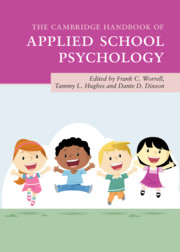Book contents
- The Cambridge Handbook of Applied School Psychology
- The Cambridge Handbook of Applied School Psychology
- Copyright page
- Contents
- Contributors
- Contributor Biographies
- Acknowledgments
- 1 Broadening the Focus of School Psychology Practice
- Part I Individual-Level Academic Interventions
- Part II Teacher- and System-Level Interventions
- Part III Interventions from Educational and Social/Personality Psychology
- Part IV Behavioral and Social-Emotional Interventions
- Part V Health and Pediatric Interventions
- Part VI Family Connections and Life Transitions
- 30 Parent–Teacher Relationships
- 31 The School Psychologist’s Role in Facilitating the Transition to College
- 32 Transition from School to Work within a Theory-based Problem-Solving Framework
- Part VII Special Populations
- Part VIII Conclusion
- Index
- References
30 - Parent–Teacher Relationships
from Part VI - Family Connections and Life Transitions
Published online by Cambridge University Press: 18 September 2020
- The Cambridge Handbook of Applied School Psychology
- The Cambridge Handbook of Applied School Psychology
- Copyright page
- Contents
- Contributors
- Contributor Biographies
- Acknowledgments
- 1 Broadening the Focus of School Psychology Practice
- Part I Individual-Level Academic Interventions
- Part II Teacher- and System-Level Interventions
- Part III Interventions from Educational and Social/Personality Psychology
- Part IV Behavioral and Social-Emotional Interventions
- Part V Health and Pediatric Interventions
- Part VI Family Connections and Life Transitions
- 30 Parent–Teacher Relationships
- 31 The School Psychologist’s Role in Facilitating the Transition to College
- 32 Transition from School to Work within a Theory-based Problem-Solving Framework
- Part VII Special Populations
- Part VIII Conclusion
- Index
- References
Summary
There are many benefits to parent participation in schooling. When parents and teachers work together, students show better achievement and behavioral skills. However, creating and maintaining productive parent–teacher relationships can be an elusive goal due to differences in role expectations, culture, and available supports. School psychologists can promote positive parent–teacher relationships through the use of their collaboration and consultation skills. Three main areas should be addressed: (a) creating a positive atmosphere, including developing shared goals and shared decision-making power; (b) utilizing effective communication skills, such as active listening and empathic responding; and (c) developing outreach strategies that address the needs of diverse families from elementary to high school.
Keywords
- Type
- Chapter
- Information
- The Cambridge Handbook of Applied School Psychology , pp. 519 - 537Publisher: Cambridge University PressPrint publication year: 2020



